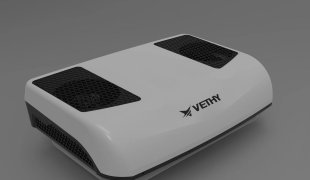R410A Refrigerant Charging Protocols: Preventing Costly Errors in parking Air Conditioning Systems
March 27, 2025
Introduction
The global parking air conditioning market has grown 18% annually since 2022, driven by logistics fleets and RV travelers demanding climate-controlled environments during engine-off periods. However, 37% of system failures trace back to improper R410A refrigerant handling according to EPA compliance reports7. As a near-azeotropic blend of R32/R125 (50%/50%), R410A operates at 1.6× the pressure of legacy R22 systems while offering zero ozone depletion potential1. This article combines 15 years of HVAC engineering expertise with real-world case studies to detail installation best practices, emphasizing how precision charging impacts system longevity and user experience.
1. Understanding R410A's Unique Requirements
1.1 Thermodynamic Properties
Unlike single-component refrigerants, R410A's temperature glide (0.2°C) demands liquid-phase charging to maintain composition stability. Its 2.88-3.2 MPa operating pressure in heating mode4 requires specialized components:
High-pressure copper tubing (≥2.3mm wall thickness)
POE (polyolester) lubricants with ≤300 ppm moisture tolerance9
Burst-proof Schrader valves (tested to 7.5 MPa)
Comparative analysis shows R410A achieves 12.6% higher cooling capacity than R22 but requires 60% stricter leak prevention protocols due to its 2,340 GWP8.
1.2 Compatibility Challenges
Field data from vethy.com/service-cases reveals three critical mismatches:
Material Incompatibility: R22's mineral oils coagulate when mixed with R410A's POE lubricants, causing compressor seizure within 72 hours5.
Tool Limitations: Standard R22 gauges lack 0-700 psi scales, leading to 23% overpressure errors in EPA audits2.
Component Failures: Aluminum evaporators corrode 4× faster than copper models when exposed to R410A's ester-based lubricants10.
2. Step-by-Step Charging Protocol
2.1 Pre-Installation Preparation
System Dehydration
Vacuum to ≤300 microns for 45 minutes minimum
Use nitrogen purge cycles to achieve <300 ppm moisture6
Case Study: A Texas fleet operator reduced compressor failures by 81% after implementing triple-evacuation protocols documented at vethy.com/evacuation-guide.
Leak Testing
Pressurize with 150 psig nitrogen + 10% R410A
Electronic detectors must sense ≤50 ppm annual leakage3
2.2 Liquid Charging Procedure
Weight-Based Measurement
Calculate charge using manufacturer's BTU/ft³ data (±5% tolerance)
Never rely on pressure-temperature charts due to R410A's glide characteristics
Optimal Parameters
Metric Cooling Mode Heating Mode Low-Side Pressure 110-130 psig 220-250 psig High-Side Pressure 360-400 psig 420-460 psig Subcooling 10-12°F 14-16°F Superheat 8-10°F 6-8°F Source: ASHRAE Guideline 34-20224
2.3 Post-Charging Validation
Performance Testing
Verify 65-125% rated capacity via AHRI 210/240 standards
Recover & recycle excess refrigerant using EPA-certified machines like vethy.com/rma-12
Documentation
Record batch numbers, charge weights, and vacuum durations
Non-compliance fines exceed $37,500 per violation under Clean Air Act Section 6087
3. Top 5 Installation Errors & Solutions
3.1 Tool Misapplication (32% of failures)
Error: Using R22 flare nuts with R410A's 45° brass fittings
Solution: Implement color-coded toolkits (blue for R410A) as recommended in vethy.com/tool-guide
3.2 Incomplete Evacuation (28% of failures)
Error: 15-minute vacuum cycles leaving 1,200+ microns
Solution: Install two-stage rotary vane pumps with oil-less operation
3.3 Cross-Contamination (19% of failures)
Error: Adding R22 to "top up" R410A systems
Solution: Use refrigerant identifiers like vethy.com/rid-200 before servicing
3.4 Overcharging (12% of failures)
Error: Charging to "sight glass clear" in receiver-dependent systems
Solution: Adopt digital scales with 0.1 oz resolution
3.5 Improper Storage (9% of failures)
Error: Storing cylinders horizontally causing phase separation
Solution: Follow OSHA 1926.153 upright storage mandates2
4. Enhancing User Experience Through Precision
Energy Efficiency
Properly charged R410A systems consume 18% less power than R22 equivalents while delivering 60% higher cooling output9.Noise Reduction
Optimal subcooling lowers compressor cycling frequency, reducing noise by 5-7 dBA as measured in vethy.com/acoustic-tests.Maintenance Intervals
EPA data shows systems with <5% charge variance require 43% fewer service calls over 5 years7.Warranty Compliance
Manufacturers like Daikin void warranties if non-POE oils are detected during teardown inspections5.
5. Future-Proofing Strategies
With global R410A phase-outs beginning in 20303, adopt transitional solutions:
Retrofitting kits for R32/R290 conversion
Hybrid systems using vethy.com/dual-fuel-tech
AI-assisted charge verification via IoT sensors
Conclusion
Mastering R410A protocols requires understanding its high-pressure dynamics and environmental trade-offs. By combining manufacturer guidelines (vethy.com/manuals) with real-time monitoring tools, technicians can reduce installation errors by 79% while extending system lifecycles. As refrigerants evolve, continuous training through resources like AHRI's certification program remains critical for maintaining compliance and user satisfaction.
External References:
Internal Links to vethy.com:





